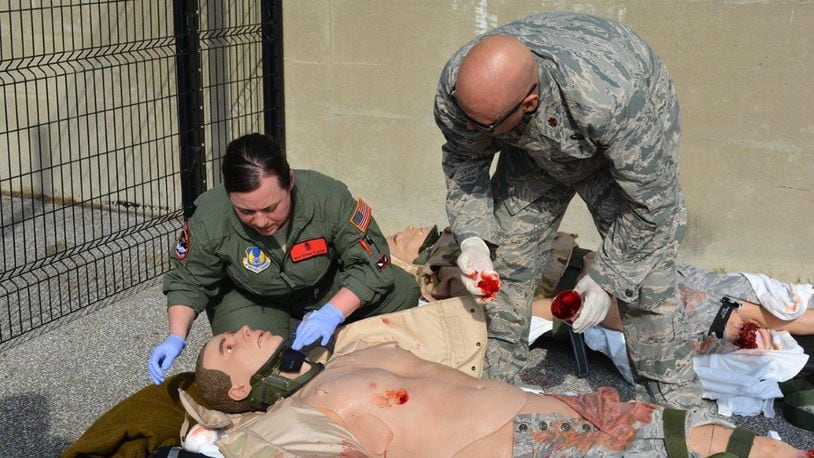“This training is a critical part of deployment readiness, and the high-level, hands-on experiences our medical teams receive here is phenomenal,” said Chief Master Sgt. Jason France, AFMC command chief. “A key part of the AFMC mission is to produce competent, agile Airmen ready for deployment in any environment. This training and simulation is a vital tool in the readiness arsenal.”
The TCCET training is an advanced tactical combat casualty care course offered by the Cincinnati Center for Sustainment of Trauma and Readiness Skills. The C-STARS is a joint partnership between the University of Cincinnati Medical Center and the Air Force, with the mission to provide hands-on, realistic training for military medical personnel in trauma and critical care.
One of three C-STARS training platforms in the U.S., the Cincinnati C-STARS trains more than 250 military critical care air transport teams annually, evaluating and certifying that casualty care teams are capable and ready to provide emergency treatment to seriously injured patients at point of injury so they can be transported to military treatment facilities for further care.
Air Force CCATTs are three-person teams, typically comprised of a critical care or emergency room physician, respiratory therapist and critical care nurse. The teams specialize in treating acute trauma patients, with C-STARS providing the opportunity to maintain and refresh skills, ensuring readiness for crisis care.
“Air Force combat medical personnel are highly skilled, but working in military hospitals, they are not exposed to trauma patients on a regular basis. Illnesses and routine care are the bulk of the cases these clinicians see on a daily basis,” said Marvin Shelton, an administrator in the En Route Care Training Department at the U.S. Air Force School of Aerospace Medicine, Wright-Patterson Air Force Base. “Through partnerships with leading civilian trauma centers in the U.S., we established the C-STARS to provide the trauma care skills our military medics need to provide care in deployed environments.”
During the weeklong TCCET training, combat medic teams undergo extensive simulation training, with realistic patient scenarios to test their abilities to implement critical patient guidelines during a mission. Unique to this training is the hands-on experience teams receive in providing trauma treatment during flight, where altitude, turbulence and space limitations all provide challenges to administration of medical care.
During France’s visit, TCCET training teams exercised trauma care scenarios aboard an Army National Guard UH-60 Blackhawk helicopter. In the cramped, 8-by-8 foot space in the UH-60’s back bay, the teams of three practiced simultaneous treatment of two “patients,” learning quickly of the challenges presented by space limitations, equipment and communication in turbulent air space.
“This is a challenging class, and it really takes me out of my comfort zone,” said Senior Airman Lawrence Castanares, a respiratory therapist with the 624th Aeromedical Staging Squadron, Hickam Air Force Base, Hawaii, and TCCET trainee. “It’s great to be able to interact with doctors and nurses and gain insights to the challenges I might face during irregular missions on deployment. The hands-on work is invaluable.”
For France, personally seeing and experiencing the TCCET training and interacting with the Airmen teams really brought home the importance of this less-known AFMC mission capability.
“These are hard-working Airmen doing an important mission for AFMC and the Air Force. We develop more than just systems and platforms at AFMC. We are ensuring the next generation of ready, agile and empowered Airmen,” he said.
About the Author
